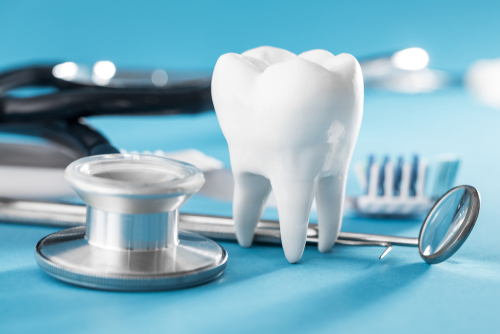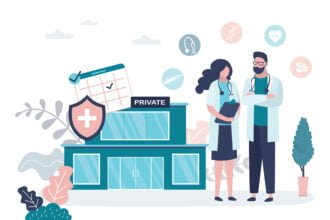Everyone has their own memories of childhood fears, some of which become straight up ridiculous and disappear with time. But other phobias stay through the years, affecting our habits and daily routines. For many people, such a phobia is the fear of dentists.
The fear makes patients hesitant about scheduling a dentist visit until they feel discomfort or pain. Sometimes, they will subdue the sensations with over-the-counter painkillers and wait until the problem becomes too big to ignore.
Additionally, a lot of patients won’t consider scheduling preventive oral checkups without dental insurance, increasing the risks to develop dental acuities and overall health issues, such as heart disease, diabetes, and osteoporosis. As of 2016, around 74 million patients had no dental care coverage.
Being a technology-driven healthcare domain by default, it’s no surprise that dentistry seeks for acquiring new tech approaches that will help health specialists provide more comfortable preventive and reactive patient care with better timing and improved health outcomes. This time, the internet of things or IoT is on the radar. It comes in different shapes and sizes with a promise to help patients stay out of dentist offices as long as possible.
State Of The Art In Dental IoT
The IoT network of devices is growing exponentially, because practically every new product on the market is becoming reinvented and “smart” with embedded software, from light bulbs and fridges to shoes and pet feeders. This software allows devices to communicate with the internet and either updates their existing functionality with new features or enables previously impossible functionality.
IoT slowly spreads across many healthcare domains due to its ability to gather patient data and cover communication gaps between care consumers and health specialists. Of course, dentists are the one to have major communication gaps with their patients who are afraid of them and will avoid new appointments as long as possible.
Therefore, we at Itransition are very interested in discovering the ways for IoT to help the dental care become more hi-tech and less terrifying.
The Tsunami Of Smart Toothbrushes
Remembering the details of their most unsuccessful visit to a dentist, children grow up into adults who can’t overcome their fears of doctors and dental chairs so they won’t schedule a visit until there’s a dire need. Even when such people can be really dedicated to their dental hygiene, brushing two times a day for 3 minutes in a row and never forgetting to floss, they still can develop caries without regular checks and timely adjustments in dental care.
While dentists can’t rewind the negative patient experience to make the individuals fear less and schedule appointments more often, they can help patients to improve their prevention efforts with distant consultations and timely advice. To achieve that, health specialists need access to varied patient data, especially to some details that patients can’t even articulate themselves, such as their brushing and flossing motions.
Here’s where smart brushes come into play. Currently, connected brushes are capable of gathering a lot of patient data with the help of embedded cameras, location tracking, pH sensors, pressure sensors and timers, including:
- Teeth scans
- Brushing habits and patterns
- The overall time of brushing by day, by week, by month, etc.
- Saliva samples
- Blood alcohol levels and more
Yes, the brushes can be that advanced. Now, patients can brush their teeth and get an oral exam during that time. The brush takes photos of the mouth cavity and sends them to the provider’s server, where AI analyzes the scans to detect cavities, cracks or any other abnormalities that may require a dentist’s attention. If the preliminary analysis will show anything concerning, both the dentist and the patient will be notified. The patient will be suggested to schedule an office visit.
Additionally, the brush can detect acidic saliva without lab tests, helping the dentist improve patient oral care in time and preventing patients from developing caries or gum disease. Some brushes also start to sense specific chemicals in the patient’s breath to enable pre-diagnosis of diabetes.
On a more basic level, smart brushes can also evaluate patient brushing habits, such as particular time dedicated to oral hygiene, noticing if a patient misses the spot or puts too much pressure on the brush. But even this information can be used to significantly help patients. For example, Beam Dental offers the care consumers to use a smart brush and improve their brushing habits to get lower premiums for their dental insurance.
According to the company, their approach of incentivizing dental self-care is working incredibly well, making the care consumers patients brushing two times longer and more frequently.
For those patients who don’t want a novelty brush but still need to improve their brushing habits, Brushlink created an attachable device to click on any brush and make it smart. This attachment allows patients to track brushing duration and performance as well as define brushing angles to provide informed and real-time guidance via the dedicated app. The aggregated patient data is synced with the app and stored for three months, so patients can share their summaries with dentists online or during an appointment.
First Waves Of Smart Teeth
Another IoT direction that can benefit dental care consumers is rooted in making human teeth smart and connected. It’s either someone got too excited about old-school spy movies or there is an outstanding benefit from chipping a person’s tooth or implanting a smart tooth instead of a missing one.
In our opinion, it is the latter. Adding connectivity to the mouth cavity will allow collecting important patient data, such as bruxism, food intake, activity levels, and brushing habits.
Same as with smart brushes, collected patient data will be transferred to providers’ servers and analyzed to decide on next steps. For example, if a patient’s brushing habits need improvement, their dentist will send out the guidelines. Moreover, the food intake data can be sent out to the patient’s physician or nutritionist to enable personalized recommendations on needed diet improvements. This functionality can be especially useful for patients with higher risks to develop caries and uloglossitis.
The Future Of Dental IoT
It is difficult to envision the particular innovations in dentistry IoT because this domain is just arising. Still, the next anticipated smartifications can be targeted at improving the dentist office to make it way less hostile. We’re thinking connected thermometers, music stations, VR glasses, smart walls or even ceilings to create the comfortable atmosphere for a patient according to their preferences and even stress levels – adjusting the music and temperature to sooth the patient.







